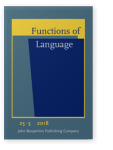Vol. 25:3 (2018) ► pp.363–391
Adapting to survive
The English absolute and its new functional niche
This paper traces the semantic development of the English absolute construction from Old to Present-day English on the basis of extensive corpus data. It is observed that the absolute construction developed from a solely adverbial, strictly subordinate construction into a construction with a much larger range of functions, including quasi-coordinate constructions whose ‘addition’ function comes close to that of and-coordinated finite clauses. This development involves an expansion of clausal status (from subordinate to anywhere between subordinate and quasi-coordinate) and a semantic expansion from typically adverbial meanings to any type of additional information. The process is claimed to have been facilitated by Middle English case loss and arguments for this facilitating role of case loss are adduced. It is then shown how these quasi-coordinate absolute constructions became more and more important as an absolute construction-function over time, as they were well-suited to the absolute construction’s high degree of syntactic independence. This evolution appears to have taken an opposite direction from the development of free adjuncts (Killie & Swann 2009: 339). This observation fits in well with the proposal that English ing-clauses form a network (Fonteyn & van de Pol 2015) in which each member maintains its own functional niche, rather than engaging in competition with one another.
Article outline
- 1.Introduction
- 2.Methodology
- 2.1Absolutes and free adjuncts identified
- 2.2Data
- 2.3Semantic categorization
- 2.3.1The five categories of AC semantics
- 2.3.2A syntactic and functional interpretation of AC semantics
- 2.3.3Dealing with semantic indeterminacy
- 3.The semantic history of ACs
- 3.1Global development
- 3.2Zooming in on Old and Middle English: Case syncretism as an enabling factor
- 3.3The inverse development of free adjuncts
- 4.Conclusion
- Acknowledgements
- Notes
-
Corpora -
References
